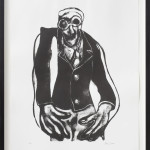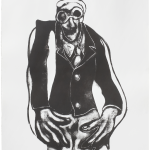Chris Gollon
Dancing Philosopher
Lithograph on 300g Arches paper. Signed edition of 10, with three artist's proofs, published by IAP Fine Art in 2010. Eight sold, ONLY two remaining from this edition. Unframed price shown, framed price £1,850.
28 x 22 in
71.1 x 55.9 cm
71.1 x 55.9 cm
Edition of 10 plus 3 artist's proofs
© Estate of Chris Gollon
This is the only edition of lithographs Chris Gollon ever made. It came about by chance. Whilst making a series of monotypes (one-off prints from smooth, un-etched plates), when the...
This is the only edition of lithographs Chris Gollon ever made. It came about by chance. Whilst making a series of monotypes (one-off prints from smooth, un-etched plates), when the paper was pulled off one plate to reveal the image ‘The Dancing Philosopher (I)’ (see page 1 of Tamsin Pickeral’s biography), a very rare thing happened.
The ink remaining on the smooth aluminium plate was not the usual abstract mush that usually gets wiped off immediately. It was very unusual, but the ink seemed to have stayed roughly in the shape of the image. The Goldmark Atelier's master printmaker, Ian Wilkinson, immediately had the idea to flip the plate face down onto a lithographic stone, and to use the heavy etching press to press it down onto the stone, pushing the ink into the porous surface of the stone. The image then appeared in the stone, and Chris Gollon was asked to add more ink and brushstrokes where needed to make a slightly differing image. It then became possible to make a small edition of just 10 lithographs.
Chris Gollon was delighted with the outcome and how the blacks differ when printed from stone, how they can become softer. He enjoyed and excelled in making monotypes, often re-importing the techniques used in this one-off printmaking process into his paintings. Tamsin Pickeral writes very well on this in her 2010 biography of Chris Gollon, entitled ‘Humanity in Art’, endorsed by Bill Bryson OBE.
The ink remaining on the smooth aluminium plate was not the usual abstract mush that usually gets wiped off immediately. It was very unusual, but the ink seemed to have stayed roughly in the shape of the image. The Goldmark Atelier's master printmaker, Ian Wilkinson, immediately had the idea to flip the plate face down onto a lithographic stone, and to use the heavy etching press to press it down onto the stone, pushing the ink into the porous surface of the stone. The image then appeared in the stone, and Chris Gollon was asked to add more ink and brushstrokes where needed to make a slightly differing image. It then became possible to make a small edition of just 10 lithographs.
Chris Gollon was delighted with the outcome and how the blacks differ when printed from stone, how they can become softer. He enjoyed and excelled in making monotypes, often re-importing the techniques used in this one-off printmaking process into his paintings. Tamsin Pickeral writes very well on this in her 2010 biography of Chris Gollon, entitled ‘Humanity in Art’, endorsed by Bill Bryson OBE.



